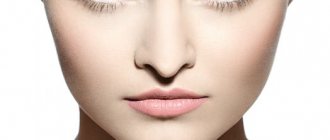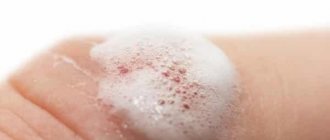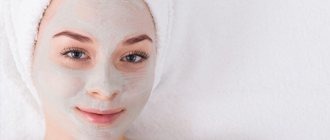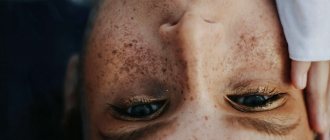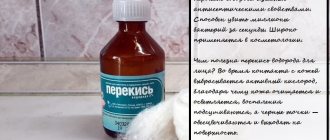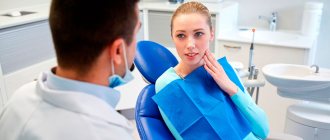Compound
The drug is supplied to pharmacy counters with a 3% concentration of the active substance. The composition is simple. The main component is hydrogen peroxide. Auxiliary – specialized water and sodium benzoate.
For retail sale, packages of 40 and 100 ml are available, packaged in:
- Medicine bottles;
- Glass bubbles;
- Dropper bottles.
Hospitals receive 0.5 and 1 liter bottles.
How to properly monitor a mole after an injury?
To objectively track changes in a mole, after the inflammation has subsided, you can take a photograph of it against the background of a ruler and compare the original image with subsequent ones. In order for the photo to be of high quality and comparison possible, the following rules must be observed:
- The photo must be taken with a camera, not a phone.
- The photo should not be a “selfie”. In such photographs, the mole is usually out of focus.
- A light source or camera flash should be directed at the mole.
Can everyone use it?
Hydrogen peroxide for acne on the face is effective if acne is caused by certain reasons, this is confirmed by dermatologists.
Among them:
- Superficial infection;
- Neglect of hygiene rules;
- Severe skin contamination.
The pharmaceutical solution is recommended to combat a small amount of rash that appears occasionally and does not persist constantly. Also, the disinfectant is effective for treating wounds after the release of purulent exudate.
In situations where acne is constantly present on the face, the causes of the disease lie in somatic disorders. Only a dermatologist can prescribe a treatment regimen after conducting a series of studies. IMPORTANT: using peroxide on a regular basis slows down local metabolic processes.
It is not recommended for use by those with dry or sensitive skin. Hydrogen peroxide can cause additional dryness, peeling, the formation of early wrinkles, and burns.
What concentration of solution can be used
Since hydrogen peroxide is a potent, aggressive substance, it must be used in a certain dosage and only if safety rules are observed.
Be sure to read:
Effective recipes from bay leaves for acne: how to quickly get rid of acne at home?
For anti-inflammatory masks, it is recommended to buy peroxide up to 3%. A product with a higher percentage can have an aggressive effect, similar to a burn, and irritate the skin even when diluted with water.
Important! It is strictly not recommended to use pure acid on the face due to the increased risk of allergies and severe chemical burns. Before use, the product must be mixed half and half with water.
The use of 3% peroxide must be approached with extreme caution and not used more than 3 times every 7 days. Before use, it is better to consult a dermatologist.
Peroxide against acne: application
The simplest way to combat acne is to wipe the pimples with hydrogen peroxide. Before the procedure, you need to cleanse your face using mild cleansers. Next, cauterize the rash with peroxide using a cotton swab and grabbing the inflamed area. After drying, moisturize your face with cream. It is important to avoid applying the product to healthy areas of the dermis, so as not to injure them.
In addition to being used in its pure form, hydrogen peroxide is added to home care cosmetics.
Tonic
Hydrogen peroxide effectively helps against acne as part of a toner, which also copes with spots and pigmentation remaining after the rash has healed. It's very easy to prepare:
- Pour 50 ml of the finished tonic with anti-acne effect into a clean bottle;
- Add 5-6 drops of peroxide to the liquid;
- Wipe your face in the morning 2 times a week.
Masks
An effective method for eliminating acne is masks, and, depending on the components, they are suitable not only for those with oily skin, but also for dry, sensitive ones. An important condition for treatment with hydrogen peroxide is that the course lasts no more than a month. Afterwards, a pause of 90 days is necessary for rest and recovery. Cooking recipes:
- Combine a tablespoon of aloe juice and honey. Drop hydrogen peroxide into the mixture 3 times. Stir and apply to each pimple locally. Remove after 15 minutes;
- Dilute 2 tablespoons of yeast with peroxide to a sour cream consistency. The treatment regimen involves the following methods:
- Apply directly to inflammation. Repeat the procedure 2 more times after the mixture has dried. After 5 minutes, remove with a sponge;
- Apply the composition to your face and wait for it to dry. Shake off excess and go to bed. In the morning, wash your face properly;
- Take a handful of blue clay. Combine natural honey and agave pulp, ground into porridge, in a 1:1 ratio. Dilute the powder. Add some iodine and peroxide. Keep the composition for 20 minutes, wash with dark water;
- Combine ground oatmeal and mashed raw potatoes in equal proportions. Add a tablespoon of peroxide. Cover the face, neck and décolleté if there are rashes there. Wait 20 minutes;
- Combine the yolk, 5 ml of hydrogen peroxide and a tablespoon of high-fat cottage cheese. Rinse off after 10-15 minutes;
- Mix 3-4 tablets of streptocide and the same amount of baby powder. Dilute with the main ingredient. Apply with a brush to inflamed areas and leave overnight. Wash your face in the morning.
Peeling
Chemical peeling is an effective but aggressive way of cleansing the face, so you can resort to it once every 2 weeks. Cooking method:
- Mix 5 tablespoons of hydrogen peroxide with 10 g of sea salt;
- For dry skin, add clean water in the volume of a glass;
- Soak a cotton pad with the mixture;
- Apply circular movements to the face and affected areas on the back;
- Duration – minute;
- After washing or taking a shower;
- Apply cream with a moisturizing effect.
Briefly about the main thing:
In my opinion, there is currently no convincing evidence that trauma to a mole can lead to the development of melanoma. Besides me, oncology associations such as NCCN and ESMO also think the same. However, I don’t know if everything was fine with your mole BEFORE the injury. That is why, after the inflammation has subsided, I recommend contacting an oncologist, especially if this specialist has not looked at all of your moles before. If pain, redness, and swelling do not go away within a month, you need to see an oncologist as quickly as possible.
If you still have questions, the following will help you:
- In-person appointment with an oncologist
(St. Petersburg) - Mole removal
with histology (St. Petersburg) - My Online consultation (from anywhere in the world)
Hydrogen peroxide for acne spots (post-acne)
The product is effective in combating post-acne due to the ability of peroxide to lighten the skin. Acne spots are removed using a special mask, as in its pure form it can leave burns. Recipe:
- Mix cosmetic clay of any color and bodyagu in equal parts;
- Add 5 drops of peroxide;
- Dilute with purified water;
- Apply at night 1-2 times a week.
Hydrogen peroxide for post-acne is effective as part of the yeast mask described above. The method of application is similar to the fight against acne, only in this case the composition must be applied to acne marks and spots.
Will using antiseptics help get rid of acne?
Before cauterizing a pimple*, it is important to understand that it can have negative consequences. In the fight against acne, you cannot act on your own, because this disease requires an exclusively professional approach to treatment. Only an experienced doctor can determine its causes and select effective methods of therapy.
Acne requires medical treatment; you cannot get rid of it using improvised means. Treatment of the disease is aimed at reducing inflammation and the number of pathogenic microorganisms, reducing hyperkeratinization, restoring normal functioning of the sebaceous glands, and reducing the effect of hormones on the skin.
Various drugs can be used to eliminate inflammatory elements. For example, topical retinoids, which have anti-inflammatory and comedolytic effects, azelaic acid, which has moderate antiseborrheic and anti-inflammatory effects, hormonal drugs, antibiotics.
The choice of a specific agent depends on the sensitivity of microorganisms to its active substances. Therefore, before starting therapy, the specialist conducts bacteriological culture.
For the treatment of mild acne, only external medications are usually used. But in more complex clinical cases, a combination of topical and systemic drugs may be required.
In the absence of inflammation on the skin, cosmetic procedures can also be performed to improve the condition of the skin. These can be peelings, injection procedures (meso-, plasma therapy), etc.
In what cases will treatment be effective?
Given peroxide's ability to burn skin, it is important to use it only in cases where use is warranted. This:
- Clogged pores with excess secretions and dust;
- Minor damage to the epidermis;
- Local activity of microbes and bacteria;
- Formation of single cold pimples;
- Treatment of the wound after removal of purulent contents;
- Lightening pigmentation.
Peroxide is useless in situations of accumulation of constant rashes. Also, using the solution will not work when trying to treat closed comedones and deep subcutaneous pimples.
How to bleach and remove hair
To obtain the desired result, apply hydrogen peroxide along the hairs. Oxidative stress discolors, weakens unwanted vegetation, and causes it to fall out.
Recipe 1:
- Dilute hydrogen peroxide with the same amount of boiled water.
- Apply carefully to unwanted hairs, avoid contact with skin.
After 5-10 minutes, rinse with cool water.
To increase the effectiveness of the procedure, peroxide is mixed with baking soda. Baking soda opens the cuticle (the outer shell of the hair), as a result, peroxide penetrates inside more easily and discolors melanin.
Recipe 2:
- Mix both ingredients to a paste consistency.
- Apply gently along unwanted hairs without touching the skin.
After 5-10 minutes, rinse with cool water.
Contraindications and side effects
Due to the fact that peroxide causes burns, it is strictly forbidden to apply it to healthy skin. The epidermis is injured, moreover, the regeneration process of inflamed areas slows down.
It is important to apply hydrogen peroxide to the affected areas no more than 2 times a day, otherwise the harm outweighs the benefit. 2 wettings are enough for the formation to begin to decrease. If this does not happen, you need to visit a dermatologist.
The drug has practically no contraindications, but causes side effects expressed in the following “moments”:
- Itching and tingling;
- Allergic redness;
- Dryness and tightness.
Additional precautions:
- Avoid ingestion;
- Carefully follow the instructions for use;
- Avoid contact with mucous membranes.
Is mole injury really dangerous?
In RuNet, the danger of traumatizing moles is given excessive, in my opinion, importance. Is there any justification for this point of view? Absolutely, but I think it's quite shaky.
Indeed, there are several studies on this issue, mostly conducted in the 60s–80s of the last century. They show that 30–50% of patients in whom melanoma developed against the background of a nevus noted single or repeated trauma to the mole.
There are several arguments against these studies:
- Just because melanoma develops after trauma to a nevus does not necessarily mean that the two are related. Melanoma could develop both before trauma and much later for other reasons .
- A 2010 meta-analysis (summarizing data from 9 studies) showed that performing an incisional biopsy does not affect the prognosis of melanoma. In other words, if a piece is cut off from melanoma (for diagnostic purposes), this will not negatively affect the patient’s chances of living 5 years or more.
- The conclusions of the authors of several studies (55, 115, 147 and 498 patients) agree on one thing - incomplete removal of nevi, except for dysplastic ones with severe dysplasia, does not lead to the development of melanoma.
Here the corrosive reader will say: “Aha! Still, incomplete removal (you can read “trauma”) causes the development of melanoma!” No. A dysplastic nevus with severe dysplasia itself has a high chance of becoming melanoma in the future. The connection between incomplete removal and the development of melanoma from such nevi has not been proven .
- My experience. Almost every day people write to me who have injured a mole and are now preparing to “die” because they have read too much on the Internet. Almost any person who has a mole protruding above the skin has injured it in one way or another at least once in their life. If trauma to a mole were really a risk factor, in our country with a population of 146,000,000, the diagnosis of melanoma would be made much more often than 8,000 times a year.
